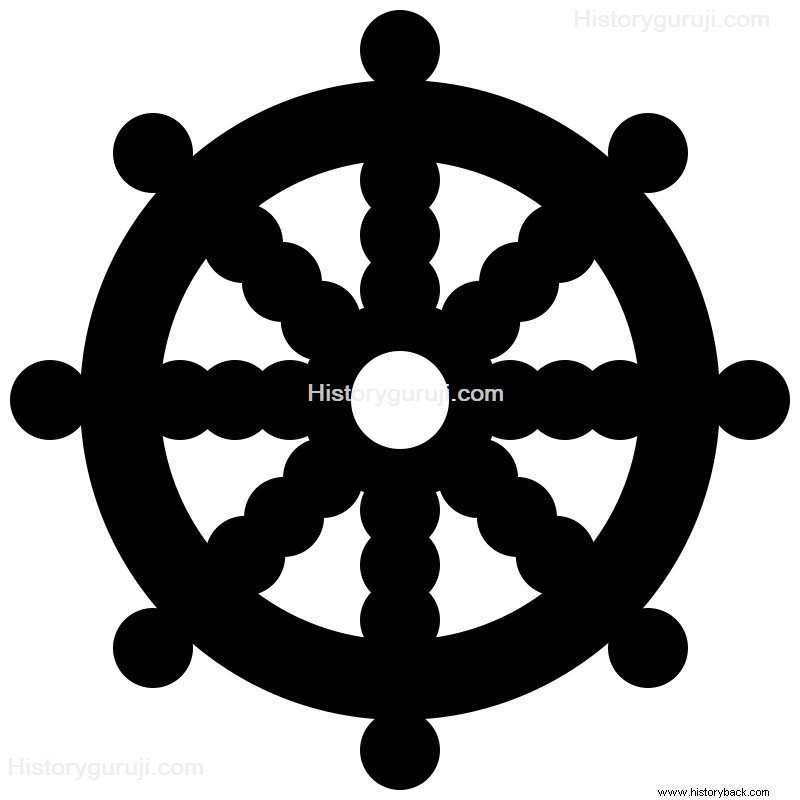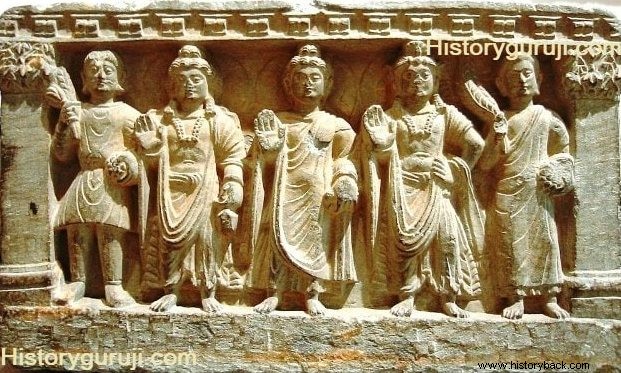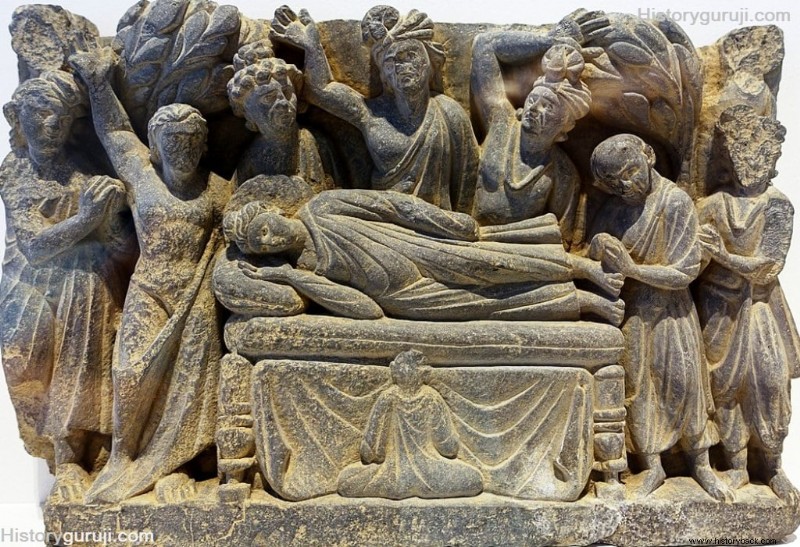Birth and Early Life of Gautam Buddha
The rise of Buddhism as a new intellectual movement dates back to BC. It was the most epoch-making event of the sixth century. Gautam Buddha, the originator and founder of Buddhism, was born around 563 BC. On the day of Baishakh Purnima from the womb of Queen Mahamaya in the Lumbini forest near Kapilvastu, the capital of the Shakyas, identified as Rumindei located on the Indo-Nepal border. done, happened. From here an inscription-containing pillar of Mauryan Emperor Ashoka has been found in 1895 AD, which is inscribed, 'Hid Budhe Jaate Sakyamuniti Hid Bhagwa Jaateti ' That is, here Shakyamuni Buddha was born, here God was born. His father's name is Shuddhodhan Who was the Shakya dynasty ruler of the Kapilvastu Republic on the banks of the Himalayas and was under Kosala. After the birth of the Bodhisattva, Kaldeval and Kaudinya propounded the view that he would either be a Chakravarti emperor or would renounce the world and become a noted scholar. In the naming ceremony on the fifth day, the child was given a meaningful name 'Siddharth , Koliya Mata Mahamaya died on the seventh day of her birth, due to which she was brought up by her maternal uncle Mahaprajapati Gautami, due to which she was 'Gautam ' Said.
Child Siddhartha was given various crafts, weapons and arts, as well as bookish and Kshatriya tactical education. King Shuddhodhana, worried by the predictions of the astrologers, placed Siddhartha in extreme luxuries so that he would not be detached from the world's fascination and charm and did not experience sorrow and suffering. At the age of sixteen, to bind Gautam to the world, he was the daughter of the Shakya dynasty's Roopvati Yashodhara He married her. Within a few years, Siddhartha also became the father of a radiant son, but Gautam was not happy with the birth of a son and it came out of his mouth that 'Rahu ' (bondage) has arisen. Hence the name of the newborn baby was 'Rahul'.
According to Buddhist texts, Siddhartha's mind was neither engrossed in offerings made for different seasons, nor in the attraction of his wife. He always contemplated on the subject of retiring from the sufferings of the world, and wanted to get rid of worldly attachments and illusions. In the later Buddhist literature, there is a mention of four trouble-collecting incidents - the old man with a shabby body, the suffering patient, the deceased and the Vitarag sannyasin. The chain of these four events displayed by the angels did what the Shakya ruler Shuddhodana had put all his intellect and strength to save. Once again it has been proved that the future is always short, it is not possible to escape from it. Ultimately Siddhartha decided to sacrifice everything for the sake of everyone's happiness, health and happiness.
It is said that one night Gautam fell asleep while watching the dance of many beautiful courtesans. The courtesans also fell asleep. When Prince Gautam suddenly broke his sleep, the courtesans in their sleep appeared very squid and terrible. Some had hair scattered, some were almost naked and some were snoring terrifyingly. The spirit of renouncing the world had become strong in Gautam. In the end, leaving his wife Yashodhara and infant Rahul to sleep, he left the house.
Republics in Ancient India
Home-Abandonment
Siddharth at the age of 29 left home in search of knowledge for the eradication of worldly sorrows. This event is called 'Mahabhinishkraman'. It is not true that the Bodhisattvas fled without informing the people of the house, sitting on the Kanthak with the food. In the Majjhimanikaya, Gautam himself says that 'In the pre-obtained condition of attaining Bodhi, a thought arose in my mind that this householder's life was a great hindrance to the practice of a completely pure, righteous life. When I was a teenager in the rise of life with Krishna hair, despite the reluctance of my parents and weeping with tearful eyes, I cut off my hair and left the house wearing Kashaya clothes and took a strange life. It is clear that 'Bodhisattvas are about to become Parivrajaka', this it was known to Suddhodhana and Gautami for a long time and they had taken Pravrajya in front of and against their wishes.
Scholars also disagree about the reasons for Gautam's renunciation. According to later belief, this change happened suddenly, but only four scenes may not have been the only reason for his abandonment. According to Kosambi, Gautam himself left home to protect his family from the dangers of frequent wars with the neighboring Kolis over the sharing of the waters of the Rohini river. Whatever be the case, Gautama, burning with sorrow, wanted to liberate the entire humanity from sorrows by finding a way to protect the world, so he followed the path of retirement by abandoning worldly and worldly attachments in search of Aryan-knowledge.
Search of Knowledge (Aryaparyeshna)
After taking sanyasa, Siddhartha travels in search of peace, truth and knowledge Alar Kalam in Vaishali Reached the ashram of an ascetic named. Here Gautam learned many difficult yoga practices, but he was not satisfied. Based on the Majjhimanikaya Dharmananda Kosambi believes that the Bodhisattva had attained Pravrajya at home in front of the parents. Bharandu, a disciple of Alar Kalam, had his ashram in Kapilvastu and the disciples of Udrak Ramputra lived in the country of the neighboring Kolis. The Bodhisattva first learned the method of meditation from these parivrajakas and it is these people who may have given him the sanyasa-initiation. The Bodhisattva did not find it appropriate to spend time in any ashram in the Shakya or Koliya country. He himself met Alar Kalam, but being not satisfied, he left Vaishali in search of true knowledge and went towards Rajgriha.
In Rajagriha, the Bodhisattva Gautama was interviewed by the Magadha king Bimbisara, which is mentioned in the Pabbajj-sutta and Lalitavistara of Suttanipatta. According to Lalitavistara, the Bodhisattva then stayed in the ashram of a sage named Rudrak Ramputra in the sub-kantha of Rajagriha. Gautam did 'Nav Cognition Cognition in a relatively short time and with little effort. ', but even this accomplishment did not make Gautam self-satisfied. Influenced by the Bodhisattva, the five bhadravargiya brahmin-monks of Rudrak also joined him. Now, while traveling, the soldiers of Magadha district reached Sannishav Uruvela.
Siddhartha decided to do penance according to the Shramana practice of that time, sitting under a banyan tree on the idyllic bank of river Neranjar (Niranjana) in Senani village near Uruvilva. His severe penance is mentioned in the Majjhimanikaya and Lalitavistara. But even with hard penance, he did not attain the desired knowledge and his body became weak and remained a skeleton. Gautam himself says in the Majjhimnikaya- 'My hip has become like a camel's leg, my ribs have become like the crooked links of an old house, my eyes have sunk like a star in a deep well, the skin of my head has become like this. It was like a gourd withered in the sun. If I held on to the stomach, my ribs would fall in my hands, if I would touch the body, my hair would fall, if I would get up for excreta and urine, I would fall by giddiness, but I have not found a better human religion than this difficult task.'
Now Siddhartha realized that right knowledge cannot be attained through penance alone. It was during this time that he remembered his experiences of his samadhi in Krishigram. In the words of the Buddha, 'Then I remembered my father Shakya's first meditation in the cool shade of berries, perhaps the way to Bodhi.'
The Bodhisattva, having eaten kheer from Sujata's hand, gave up fasting and decided to change the path of spiritual practice by making his body firm. The five Brahmin companions of the Bodhisattva, knowing him to be corrupt by means, left him with them Mrigdav (Sarnath) near Varanasi Gone to.
intelligence
Siddharth crossed the Falgu river and came to Gaya. He carried a shearer named swastika (Srotriya) Asked for some grass for the seat, he placed a seat under the Bodhi tree and made a firm determination that 'I will not leave the seat without attaining Bodhi.' But they could not disturb Gautam's samadhi. For seven days Gautam was absorbed in penance and on the eighth day on Vaishakh Purnima, he attained enlightenment (bodhi). Now he has become a fully enlightened, Buddha or Enlightened. After attaining enlightenment, Buddha first performed Tapus and Bhallika Made him the first follower of Buddhism by preaching to two Shudra traders named.
dharma-chakra-pravartan

Buddha preached Dharma for the benefit of the world decided to First of all he preached the truth-dharma to his old Panchvargiya Brahmin monks- Kaudinya, Vappa (Vappa), Bhaddiya (Bhadrik), Mahanama and Asvajit at Sarnath (Rishipattan ) arrived. Dharmachakrapravartansutra According to the Buddha's first teachings were:Parivrajaka should avoid excessive body-distress and excessive sex-pleasure. He should follow the Satya-Chatushtya (the truth of sorrow, the truth of sorrow-community, the truth of retirement from sorrow and the Arya eighttangik path) while following the Majjhim Padiva (middle path) , Thus Buddha delivered his first sermon at Sarnath, Varanasi, 'Dharmachakrapravartan ' did.
Establishment of Buddhist Association
In Sarnath itself Buddha founded the Sangh Of. Along with the five Brahmin ascetics of Kashi and Shresthi-son Yash, the superior class of Kashi became a member of the Buddha Sangha. Buddha sent these Buddhist monks in various directions for preaching religion and public welfare and said, 'Monks, you people are for the benefit of Bahujans, for happiness, to show compassion to people, gods and human beings. Indulge in giving sermons for the welfare of the nation.'
Buddha came to Magadha from Varanasi, which was the work place of many religious preachers. In Magadha the three complex Kashyapas of Gaya - Uruvel, Nadi and Gaya Kashyapa and one of their thousands of followers became Buddhist monks and in Rajagriha two disciples of Parivrajaka Acharya named Sanjaya - Kolita and Upastishya took the discipleship of the Buddha, who later became known as Shariputra and Maudgalyayan.
King of Magadha, Bimbisara, revered the Buddha as 'Venuvan The vihara named ' was given as a gift. The Buddha spent the second, third and fourth rainy seasons in Rajagriha. Ajatashatru was not initially favorable towards Buddha, but later on Shramanyafalsutra He had changed his mind after hearing that.
Buddha also traveled to Gaya, Nalanda, Pataliputra etc. and made many people his followers.
While in Rajagriha, he also once visited his hometown of Kapilvastu. The Shakyas were not friendly towards Buddha at first, but later their vision changed with Pratiharya-darshan. The Shakyas asked him to inaugurate his newly built institute Had it done. The mention of Pravrajya of Rahul is found in Vinay. Suppavasa in Kolis Was a famous worshiper of Buddha.
After walking from Rajagriha, Buddha reached Vaishali, the capital of the Lichchhavis. Here he spent the fifth rainy season. The Lichchhavis built the famous Kutagarshala in Mahavan for his residence. Making Nirgrantha worshiper Lichchavi Senapati Singh his follower was a great achievement of Buddha's rule.

Amrapali, the famous town bride of Vaishali, accepts the Buddha's discipleship and provided his Amravatika for the residence of the monks. At this place Buddha allowed women to enter the Sangh for the first time and Bhikkhu-Sangh established did. First lady Buddha's step mother Mahaprajapati Gautami to enter the Sangh She had reached there after the death of Shuddhodhana from Kapilvastu.
While going from Kapilvastu to Rajagriha, Buddha rested for some time at a place called Anupiya. It was at this place that the Shakya kings, accompanied by Bhadrik, Anuruddha, Upali, Ananda, Devadatta, met Buddha. The Buddha initiated all of them into siddharma and made Ananda his personal servant.
From Vaishali the Buddha went to Sumsumagiri, the capital of the Bhaga, and spent the eighth rainy season there. Here Abhay prince and Nakula's parents accepted Saddharma. From here the Buddha went to Kosambi and rested there for the ninth time. Udayana was initially not interested in Buddhism, but Bhikkhu Pindola He became a follower of Buddha under the influence of Bharadwaja. At Kosambi, the Buddha ordained Vyasha, Kubjotara and other women and men. यहाँ के विख्यात श्रेष्ठी घोषित ने बुद्ध के निवास के लिए घोषिताराम नाम का एक सुंदर उद्यान बनवाया। यहीं से भगवान् बुद्ध मथुरा होते हुए वेरंजा गये और वहाँ बारहवाँ वर्षावास किया।
अवंति नरेश प्रद्योत ने भी बुद्ध को आमंत्रित किया था, किंतु बुद्ध वहाँ स्वयं नहीं जा सके और अपने शिष्य महाकच्चायन को उपदेश देने के लिए वहाँ भेजा था। बुद्ध ने चंपा और कजंगल की भी यात्रा की और वहाँ के लागों को अपने धर्म में दीक्षित किया।
सद्धर्म का सबसे अधिक प्रचार कोशल राज्य में हुआ जहाँ बुद्ध ने इक्कीस बार वास किया। प्रसिद्ध श्रेष्ठि अनाथपिंडिक ने बुद्ध की शिष्यता गहण की और श्रावस्ती में भिक्षु-संघ के लिए ‘जेतवन ’ विहार अठारह करोड़ स्वर्णमुद्राओं में राजकुमार जेत से खरीद कर दान किया। इस दान का अंकन भरहुत के एक शिल्प पर मिलता है- जेतवन अनाथपिंडको देति कोटिसम्थतेनकता।
कोशल में राजा प्रसेजनजित् बुद्ध के अनुग थे और उनसे अधिक रानी मल्लिका बुद्ध में श्रद्धा रखती थी। बुद्ध की एक अनुयायी विशाखा ने संघ के लिए पुब्बाराम-मिगारमातुपासाद (पूर्वाराम मृगारमातु प्रासाद) का निर्माण करवाया। बुद्ध जेतवन और पूर्वाराम में बारी-बारी निवास करते थे।
श्रावस्ती निवास के दौरान ही बुद्ध ने प्रसिद्ध क्रूर डाकू अंगुलिमाल को अपना अनुयायी बनाया। कोशल के अनेक प्रभावशाली और समृद्ध ब्राह्मणों- झीनक (अग्निक) भारद्वाज, पुष्कर सादी, धानजनि आदि ने भी बौद्ध धर्म स्वीकार किया।
पावा के मल्लों में दर्व (दब्ब) और चुन्द सुविदित अनुयायी थे। इस प्रकार बुद्ध ने धर्म की देशना कोशल, मगध और उनके पड़ोसी गणराज्यों में की और समाज के सभी वर्गों और जातियों से उनके अनुयायियों की संख्या बढ़़ी।
महापरिनिर्वाण (Mahaparinirvana)

महापरिनिब्बानसुत्त में बुद्ध की अंतिम पदयात्रा का मार्मिक विवरण मिलता है। बुद्ध राजगृह में थे जब अजातशत्रु वज्जियों पर अभियान करना चाहता था। मगध के महामात्य ब्राह्मण वर्षकार (वस्सकार) ने बुद्ध से इस विषय पर पूछा। बुद्ध ने वज्जियों के सात अपरिहारणीय धर्म बताये, जिनके रहते वे अपराजेय थे।
राजगृह से बुद्ध पाटलिग्राम होते हुए गंगा पार कर वैशाली पहुँचे, जहाँ गणिका आम्रपाली ने उनको भिक्षु-संघ के साथ भोजन कराया। इस समय परिनिर्वाण के तीन मास शेष थे। भगवान् ने वर्षावास समीप के ‘वेलुवग्राम ’ में व्यतीत किया। यहाँ वे अत्यधिक रुग्ण हो गये और आनंद की इस आशंका पर कि कहीं भिक्षु-संघ से बिना कुछ कहे ही भगवान् का परिनिर्वाण न हो जाये, उन्होंने स्वयं कहा, ‘मैं अब जीर्ण वृद्ध हूँ। अस्सी वर्ष की मेरी आयु है…, जैसे जर्जर शकट हो। अतएव आनंद! आत्मदीप बनकर आत्मशरण, अनन्यशरण, धर्मदीप, धर्मशरण बनकर तुम लोग बिहरो ।’’
वैशाली से बुद्ध भंडग्राम और भोगनगर होते हुए पावा पहुँचे, जहाँ उन्होंने चुंद कम्मारपुत्त का आतिथ्य स्वीकार किया और ‘सूकरमद्यव’ (जंगली कंद भड़फोड़ ) खाने से उन्हें यंत्रणामय रक्तातिसार हो गया। रुग्णावस्था में ही उन्होंने कुशीनगर को प्रस्थान किया और हिरण्यवती नदी पारकर वे शालवन में दो साल वृक्षों के बीच लेट गये।
सुभद्र नामक परिव्राजक को उन्होंने अंतिम उपदेश किया और भिक्षुओं से कहा कि उनके बाद धर्म ही शास्ता रहेगा। पालि परंपरा के अनुसार तथागत ने बैशाखी पूर्णिमा के दिन यह कहकर कि, ‘‘हे भिक्षुओं! इस समय आज तुमसे इतना ही कहता हूँ कि जितने भी संस्कार हैं, सब नाश होने वाले हैं, प्रमादरहित होकर अपना कल्याण करो ’’ महापरिनिर्वाण को प्राप्त किया।
तथागत की मृत-देह का नगर के पूरब मल्लों के मुकुट-बंधन चैत्य पर जाकर अग्निदाह किया गया और अस्थि-अवशेषों का आठ भागकर कुशीनगर के मल्लों, मगध नरेश अजातशत्रु , वैशाली के लिच्छवियों, कपिलवस्तु के शाक्यों, अलकप्प के बुलियों, रामग्राम के कोलियों, बेट्ठद्वीप के ब्राह्मणों तथा पावा के मल्लों में बाँट दिया गया। इन सभी ने भगवान् बुद्ध के अस्थि-स्तूप बनवाये।
इन आठ अस्थि-स्तूपों के अलावा दो और स्तूप बने- द्रोण ब्राह्मण ने कुंभ-स्तूप और पिप्पलिवन के मोरियों ने अंगारों का स्तूप बनवाया। महावंश के अनुसार अजातशत्रु ने एक विशाल स्तूप का निर्माण करवाया और रामगाम के स्तूप को छोड़कर अन्य सात स्तूपों से सात द्रोण अस्थियों का संग्रहकर उसमें स्थापित किया। कालांतर में इसी स्तूप के अस्थियों का वितरण अशोक ने अपने द्वारा निर्मित स्तूपों में किया।
<ई.पू. छठी शताब्दी में बौद्धिक आंदोलन (Intellectual Movement in the Sixth Century BC)
>गौतम बुद्ध की शिक्षाएँ (Teachings of Gautam Buddha)
